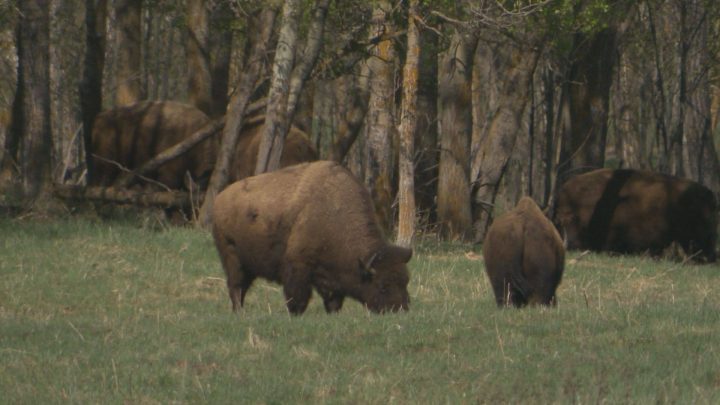Elk Island National Park is best-known for its efforts to conserve Alberta’s bison population, but representatives are welcoming plenty of other animals to the area over the summer months.

The park just east of Edmonton will see new additions from smaller species, like birds and beavers, and larger species, like moose, elk and of course, bison.
Staff are expecting upwards of 250 bison calves over the next few months, but park visitors shouldn’t expect to see any births.
“You’re not likely to see that because the females will wander off away from the groups… to calve,” Pinette Robinson, a resource management officer, said.
The newborns are often visible shortly after they’re born, as their bright red coats stand out against the landscape, earning them their nickname: “little reds.”
They don’t stay little for long. Weighing around 50 kg at birth, the calves can grow up to weigh 1,000 kg, according to Robinson.
READ MORE: Elk Island National Park sees jump in visitors with free Parks Canada passes
In addition to the calves, officials are already seeing a huge influx of birds coming into the park.
“Right now it’s spring migration, so birds are still coming up from their wintering grounds either in the U.S. or Central (and) South America,” said Jonathan DeMoor, ecologist team lead.
“They’ll be setting up territories and they’ll be having their families in June, mostly.”
Over the years, there have been more than 200 bird species spotted in the park.
“For Canada 150, I’m trying to see 150 species in the park,” DeMoor said, noting that he’s already seen more than 100 this season. “I think that should be doable.”
Amateur bird watchers can expect to see ducklings and goslings all over the park. Those with a keen eye and a pair of binoculars might spot owlets, which are often concealed in the trees.
“Before the trees leaf out entirely, is a great time to be able to actually see the birds in the canopies,” DeMoor said.
While visitors might be tempted to give the newborns a pat or a treat, park officials are reminding people to give the animals space.
“Of course they’re nervous about people,” Robinson said. “The important thing that we try to get across to visitors is that they stay a distance away.”
Robinson recommends visitors stay at least three bus lengths away from bison.
“That’s for both the bison’s safety and the visitors’ safety,” she said. “They are incredibly fast, and if they get stressed out and spooked, there is a chance that they will charge.”
READ MORE: First bison calves born in Banff National Park in over 140 years
While getting charged by a smaller animal is less likely, they can become hostile if their habitat is threatened. If people get too close to the animals, it can destroy the vegetation around them.
DeMoor noted that people should also steer clear of bird nests.
“Once they start nesting, it’s important not to harass the nest,” he said. “Some of the larger species – owls, other raptors – will actually get kind of aggressive if you get too close to their nest.”
Officials say as long as people look, but don’t touch the animals or get too close, it’s easy to stay safe.
“It’s a great time of year to come out,” Demoor said. “It’s really exciting. There’s new species coming in every day.”












Comments